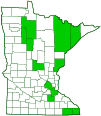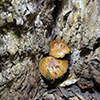White-crested Scaly
(Hemistropharia albocrenulata)
Conservation • Description • Habitat • Ecology • Distribution • Taxonomy
Conservation Status |
|
|||||||
| IUCN Red List | not listed |
|||||||
| NatureServe | not listed |
|||||||
| Minnesota | not listed |
|||||||
Description |
||
White-crested Scaly is an attractive, medium-sized, wood-rotting mushroom. It occurs in Europe and Asia; in southern Quebec and Ontario Canada; in the United States from Maine to New Jersey, west to Minnesota and Iowa, south along the Appalachian Mountains to Tennessee; and in disjunct populations in the Pacific Northwest, Arizona, and southern Mexico. It is found from July through October, alone or in groups of two or three, in deciduous and mixed woodlands. It is not uncommon, but it is seldom abundant. It grows both on living trunks and on dead stumps and logs of maple and elm and possibly other hardwood trees, rarely also on hemlock. It can obtain its nutrients from living trees (parasitic) or dead wood (saprobic). It causes heartrot of living trees. The cap is broadly cone-shaped or convex and orangish-brown to dark brown or reddish-brown. Remnants of the partial veil dot the surface with small, brown, triangular scales and cling to the margins of the cap. The surface below the scales is slimy when wet, sticky when moist, and smooth when dry. As it ages the cap spreads out with a broad bump in the middle (umbonate) or becomes nearly flat. The mature cap is 1¼″ to 4″ (3 to 10 cm) in diameter. Older caps are dark reddish-brown. The stalk is 1¼″ to 4″ (3 to 10 cm) long or longer, 3⁄16″ to ⅝″ (5 to 15 mm) thick, often curved, and more or less equal from top to bottom. It is firm and stuffed when young, becoming hollow with age. The upper part is pale or grayish, the lower part is colored the same as the cap. Part of the partial veil remains as a slight, brownish ring on the upper part of the stalk. The ring is covered with cottony, hair-like fibers (fibrillose). Sometimes there is just a fibrous area where the veil was attached, sometimes no sign of the veil remains. The area below the ring is covered with spreading brown scales. The gills are closely spaced. They may be notched at the stalk or broadly attached (adnate) and sometimes slightly running down the stalk (decurrent). They are white and tinged with gray or lilac at first, becoming grayish-brown at maturity, then brown or purplish-brown with age. The edges are finely scalloped, white, and beaded with tiny droplets of white liquid. The flesh is thick, whitish, and firm. It does not have a distinctive odor. It is inedible due to its bitter taste, but it is not poisonous. The spore print is dark brown or rusty brown but is not purplish (violaceous), like Stropharia. |
||
Similar Species |
||
Habitat and Hosts |
||
Deciduous and mixed woodlands. Maple, elm, and possibly other hardwoods, rarely on hemlock |
||
Ecology |
||
Season |
||
July through October |
||
Distribution |
||||
|
Sources |
|||
| 9/7/2022 | ||||
Occurrence |
||||
Not uncommon |
||||
Taxonomy |
|||
| Kingdom | Fungi (Fungi) | ||
| Subkingdom | Dikarya | ||
| Phylum | Basidiomycota (Basidiomycete Fungi) | ||
| Subphylum | Agaricomycotina (Higher Basidiomycetes) | ||
| Class | Agaricomycetes (Mushrooms, Bracket Fungi, Puffballs, and Allies) | ||
| Subclass | Agaricomycetidae | ||
| Order | Agaricales (Common Gilled Mushrooms and Allies) | ||
| Suborder | Agaricineae | ||
Family |
Hymenogastraceae (or Tubarieae) | ||
Genus |
Hemistropharia | ||
Family Genus |
|||
Synonyms |
|||
Agaricus albocrenulatus Dryophila albocrenulata Dryophila subsquarrosa var. fusca Hebeloma albocrenulatum Hemipholiota albocrenulata Hypodendrum albocrenulatum Pholiota albocrenulata Pholiota fusca Stropharia albocrenulata |
|||
Common Names |
|||
white-beaked Scaly (gardenlux-en.designluxpro.com) White-bellied Scale (gardenlux-en.designluxpro.com) White-crested Scaly (gardenlux-en.designluxpro.com) White-edge Pholiota (Warner Park Nature Center, Nashville, TN) |
|||
Glossary
Fibrillose
On mushrooms, covered with fine hair-like fibers.
Parasitic
Obtaining nutrients from another living organism.
Partial veil
A protective covering over the gills or pores of a developing mushroom. At maturity it disappears, collapses into a ring around the stalk, or wears away into a cobwebby covering and ring zone.
Saprobic
A term often used for saprotrophic fungi. Referring to fungi that obtain their nutrients from decayed organic matter.
Umbonate
On mushrooms, having a distinct, raised, knob-like projection in the center of the cap.
Visitor Photos |
|||||
Share your photo of this fungus. |
|||||
| This button not working for you? Simply email us at info@MinnesotaSeasons.com. Attach one or more photos and, if you like, a caption. |
|||||
Honey Fae (Farah) |
|||||
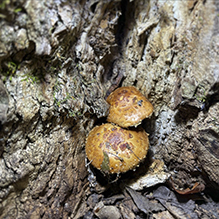 |
|||||
Bonnie Lyman |
|||||
Hello! I found this mushroom in La Crescent, MN. Stoney Point Trails/ Vetsch Park. I am wondering if I have the correct identification and could you please tell me how common it is. |
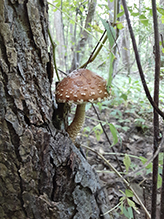 |
||||
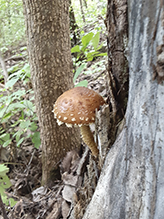 |
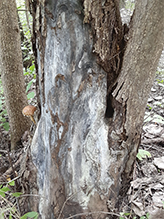 |
||||
MinnesotaSeasons.com Photos |
|||||
|
|||||

Slideshows |
||

Visitor Videos |
|||
Share your video of this fungus. |
|||
| This button not working for you? Simply email us at info@MinnesotaSeasons.com. Attach a video, a YouTube link, or a cloud storage link. |
|||
Other Videos |
|||

Visitor Sightings |
|||||
Report a sighting of this fungus. |
|||||
| This button not working for you? Simply email us at info@MinnesotaSeasons.com. Be sure to include a location. |
|||||
| Honey Fae (Farah) 9/17/2022 |
Location: Hennepin County |
||||
| Bonnie Lyman 8/21/2022 |
Location: La Crescent, MN Hello! I found this mushroom in La Crescent, MN. Stoney Point Trails/ Vetsch Park. I am wondering if I have the correct identification and could you please tell me how common it is. |
||||
| John Valo 8/22/2022 |
Yes, this appears to be Hemistropharia albocrenulata. It occurs in the eastern half of northern United States and southern Canada. Eastern Minnesota is at the western extent of its range. According to MycoWeb, it is “seldom abundant but not uncommon.” |
||||
MinnesotaSeasons.com Sightings |
|||||
|
|||||

Created: 9/7/2022
Last Updated:
